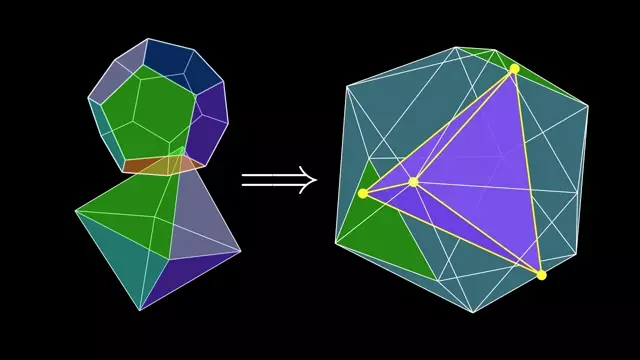2021-03-24
[public] 89.8K views, 13.4K likes, 50.0 dislikes audio only
In 1988, three engineers came together and developed one of the most clever solutions to the problem of detecting when two complex objects collide. Their solution, the Gilbert Johnson Keerthi (GJK) algorithm, named after the authors, made an incredible impact in the fields of robotics, control, and computer graphics. This video is about understanding this ingenious algorithm from first principles.
The video covers a broad range of topics from Minkowski sums and differences to support functions to the full implementation of the 2D GJK algorithm. But what I hope you get out of this is an appreciation of the incredible shifts in perspective that lead to the final algorithm. Coming up with the algorithm is an amazing feat and useful for specific applications, but the overarching problem solving techniques that come through in the journey to the solution is truly invaluable.
0:00 Introducing the Problem
2:02 Convexity
3:15 Infinite Point Perspective
4:07 Minkowski Sums and Differences
6:37 Triangles inside Minkowski Differences
7:41 Simplexes
8:57 Support Functions
13:05 Core GJK Algorithm: Broad Perspective
17:15 Remaining Key Questions
17:56 How to determine if a point passed the origin?
19:10 The line case
20:41 The triangle case
26:25 GJK Implementation
29:38 Recap and quick note about original GJK paper
This video is supported by a community of Patreons
Special Thanks to the following Patreons:
Burt Humburg
Justin Hiester
Michael Nawenstein
Richard Wells
Sebastian Gamboa
Zac Landis
There's a lot more to the GJK algorithm to learn for those interested. Here are some resources I recommend:
https://www.youtube.com/watch?v=Qupqu1xe7Io - a full walkthrough of how to implement GJK in 3D by Casey Muratori, the game developer/engineer that came up with some of the clever optimizations that I present in this video.
http://www.dyn4j.org/2010/04/gjk-gilbert-johnson-keerthi/ - a really nice writeup on GJK
https://www.youtube.com/watch?v=MDusDn8oTSE - A quick intro to GJK and an implementation in C++
https://www.toptal.com/game/video-game-physics-part-ii-collision-detection-for-solid-objects - solid resource for collision detection in general and goes deeper into the theory.
https://box2d.org/files/ErinCatto_GJK_GDC2010.pdf - an alternative perspective to GJK using barycentric coordinates -- I really wanted to cover this in this video, but it would have been an hour long instead of half an hour long so I'll compromise and give you this resource :)
Support: https://www.patreon.com/reducible
Twitter: https://twitter.com/Reducible20
This video wouldn't be possible without the open source library manim created by 3blue1brown: https://github.com/3b1b/manim
Here is link to the repository that contains the code used to generate the animations in this video: https://github.com/nipunramk/Reducible
Music attributions:
Midsummer Sky by Kevin MacLeod is licensed under a Creative Commons Attribution 4.0 license. https://creativecommons.org/licenses/by/4.0/
Source: http://incompetech.com/music/royalty-free/index.html?isrc=USUAN1100158
Artist: http://incompetech.com/
Luminous Rain by Kevin MacLeod is licensed under a Creative Commons Attribution 4.0 license. https://creativecommons.org/licenses/by/4.0/
Source: http://incompetech.com/music/royalty-free/index.html?isrc=USUAN1100169
Artist: http://incompetech.com/
Prelude No. 23 by Chris Zabriskie is licensed under a Creative Commons Attribution 4.0 license. https://creativecommons.org/licenses/by/4.0/
Source: http://chriszabriskie.com/preludes/
Artist: http://chriszabriskie.com/
All other tracks by Aakash Gandhi
/youtube/video/eED4bSkYCB8
/youtube/video/LyGKycYT2v0
/youtube/video/eu6i7WJeinw
/youtube/video/ajv46BSqcK4?t=0
/youtube/video/ajv46BSqcK4?t=122
/youtube/video/ajv46BSqcK4?t=195
/youtube/video/ajv46BSqcK4?t=247
/youtube/video/ajv46BSqcK4?t=397
/youtube/video/ajv46BSqcK4?t=461
/youtube/video/ajv46BSqcK4?t=537
/youtube/video/ajv46BSqcK4?t=785
/youtube/video/ajv46BSqcK4?t=1035
/youtube/video/ajv46BSqcK4?t=1076
/youtube/video/ajv46BSqcK4?t=1150
/youtube/video/ajv46BSqcK4?t=1241
/youtube/video/ajv46BSqcK4?t=1585
/youtube/video/ajv46BSqcK4?t=1778
https://www.patreon.com/reducible
/youtube/video/yYEMxqreA10
/youtube/channel/UCK8XIGR5kRidIw2fWqwyHRA

